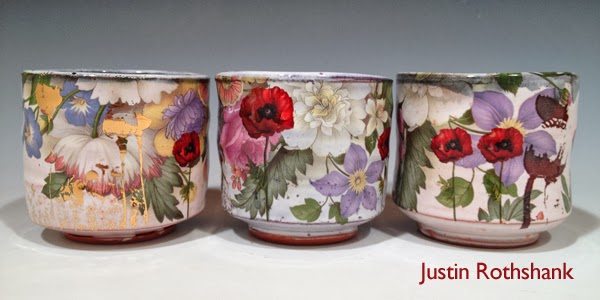Maybe you've noticed some fancy work displayed on our website's decal page -- that's the work of Justin Rothshank, master of pots, decals, and all things surface decoration. Here at The Ceramic Shop, we've long been a fan of his complex, layered work, and now that he's been working with gold luster decals -- our new obsession! -- we love it even more. Justin was kind enough to take time out of his busy schedule to answer a few questions about his process, his workflow, and his motivations. Enjoy!
What is
your driving force to create?
It's twofold. First, I love to experiment, learn, and test. I look forward to working
in the studio every day. Whether it's trying new forms for pots, making new
decals, testing new glazes, or firing kilns in a different way the rewards of
making and getting better at what I do are what drive me.
Second,
selling what we make is how my wife and I support ourselves and our family.
There's nothing like a mortgage payment or health care bill to keep you
motivated everyday.
Describe
a typical day in the studio.
I load
or unload a kiln nearly everyday. If theres a kiln to unload in the morning,
that's usually the first thing I do. I pack and ship pots several days a week.
If there's a way to put that off till later, I usually do!
Most
studio weeks rotate between a bit of glazing, a bit of making new pots, and a
bit of decorating with decals. I fire kilns 3-6 times of week depending on
production needs. I need to fire my pots 3-5 times each to complete my
decorating process.
I try to
photograph pots daily. I spend a few hours a week designing decals, and doing
computer work.
While
all of this seems like a jumble of tasks, I find a regular routine pretty
easily, and work 40-60 hours a week depending on the season.
What are
your favorite tools -- what can you not live without?
My
favorite throwing tool is a green rib from mudtools. I have a pair of red
handles scissors that I've been using for the last 10 years that are extremely
important to me for cutting out decals. Lastly, my kilns are critical to my
process and I spend a remarkable amout of time with them!
Is there
a person place or thing that was most influential in your decision to pursue a
career in the arts? This could be a teacher, a trip you took, a book, etc..
My wife
is a critical partner in my process. While she doesn't work with me in the
studio (she has her own studio for painting/drawing) her support and knowledge
of my life as a working artist has been very influential.
Secondly,
I've had a series of supportive friends over the past 10 years who have given
me guidance, shared advice, and directed me to answers for technical problems,
business solutions, and career support.
What
advice would you give someone who is looking to pursue a career in ceramics?
Whenever I'm asked this
question I always answer the same thing. Make lots of work. Tons of work. You
get better thru dedicated practice and there is no replacement for time spent
making.
..................................................................................................................
If you want to see more of Justin's awesome work, check out his website here: http://rothshank.com/justins-work/















